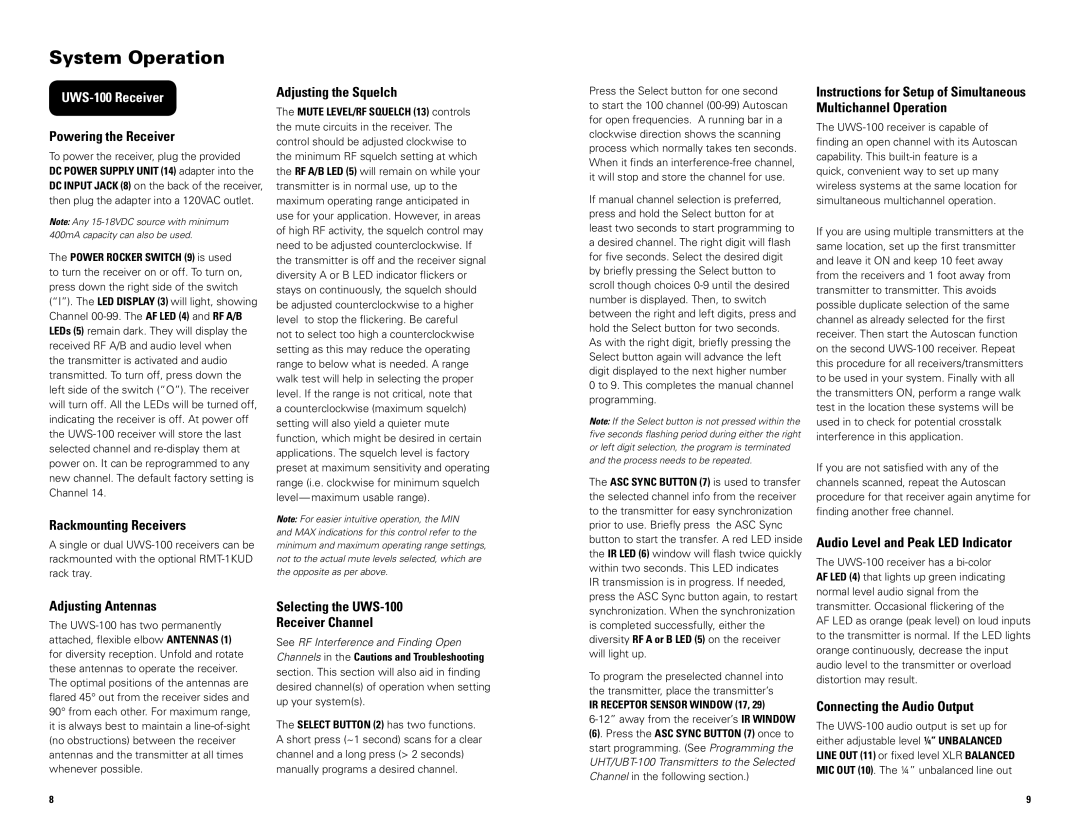System Operation
UWS-100 Receiver
Powering the Receiver
To power the receiver, plug the provided DC POWER SUPPLY UNIT (14) adapter into the DC INPUT JACK (8) on the back of the receiver, then plug the adapter into a 120VAC outlet.
Note: Any
The Power Rocker Switch (9) is used to turn the receiver on or off. To turn on, press down the right side of the switch (“I”). The LED Display (3) will light, showing Channel 00‑99. The AF LED (4) and RF A/B LEDs (5) remain dark. They will display the received RF A/B and audio level when the transmitter is activated and audio transmitted. To turn off, press down the left side of the switch (“O”). The receiver will turn off. All the LEDs will be turned off, indicating the receiver is off. At power off the
Rackmounting Receivers
A single or dual
Adjusting the Squelch
The MUTE LEVEL/RF SQUELCH (13) controls the mute circuits in the receiver. The control should be adjusted clockwise to the minimum RF squelch setting at which the RF A/B LED (5) will remain on while your transmitter is in normal use, up to the maximum operating range anticipated in use for your application. However, in areas of high RF activity, the squelch control may need to be adjusted counterclockwise. If the transmitter is off and the receiver signal diversity A or B LED indicator flickers or stays on continuously, the squelch should be adjusted counterclockwise to a higher level to stop the flickering. Be careful
not to select too high a counterclockwise setting as this may reduce the operating range to below what is needed. A range walk test will help in selecting the proper level. If the range is not critical, note that a counterclockwise (maximum squelch) setting will also yield a quieter mute function, which might be desired in certain applications. The squelch level is factory preset at maximum sensitivity and operating range (i.e. clockwise for minimum squelch
Note: For easier intuitive operation, the MIN and MAX indications for this control refer to the minimum and maximum operating range settings, not to the actual mute levels selected, which are the opposite as per above.
Press the Select button for one second to start the 100 channel
If manual channel selection is preferred, press and hold the Select button for at least two seconds to start programming to a desired channel. The right digit will flash for five seconds. Select the desired digit by briefly pressing the Select button to scroll though choices
0 to 9. This completes the manual channel programming.
Note: If the Select button is not pressed within the five seconds flashing period during either the right or left digit selection, the program is terminated and the process needs to be repeated.
The ASC Sync Button (7) is used to transfer the selected channel info from the receiver to the transmitter for easy synchronization prior to use. Briefly press the ASC Sync button to start the transfer. A red LED inside the IR LED (6) window will flash twice quickly within two seconds. This LED indicates
IR transmission is in progress. If needed, press the ASC Sync button again, to restart
Instructions for Setup of Simultaneous Multichannel Operation
The
If you are using multiple transmitters at the same location, set up the first transmitter and leave it ON and keep 10 feet away from the receivers and 1 foot away from transmitter to transmitter. This avoids possible duplicate selection of the same channel as already selected for the first receiver. Then start the Autoscan function on the second
If you are not satisfied with any of the channels scanned, repeat the Autoscan procedure for that receiver again anytime for finding another free channel.
Audio Level and Peak LED Indicator
The
Adjusting Antennas
The
Selecting the UWS-100
Receiver Channel
See RF Interference and Finding Open Channels in the Cautions and Troubleshooting section. This section will also aid in finding desired channel(s) of operation when setting up your system(s).
The Select Button (2) has two functions. A short press (~1 second) scans for a clear channel and a long press (> 2 seconds) manually programs a desired channel.
synchronization. When the synchronization is completed successfully, either the diversity RF A or B LED (5) on the receiver will light up.
To program the preselected channel into the transmitter, place the transmitter’s
IR Receptor Sensor Window (17, 29)
6-12” away from the receiver’s IR Window
(6). Press the ASC Sync Button (7) once to start programming. (See Programming the
transmitter. Occasional flickering of the
AF LED as orange (peak level) on loud inputs to the transmitter is normal. If the LED lights orange continuously, decrease the input audio level to the transmitter or overload distortion may result.
Connecting the Audio Output
The
8 | 9 |
